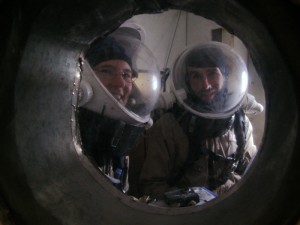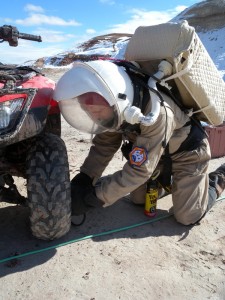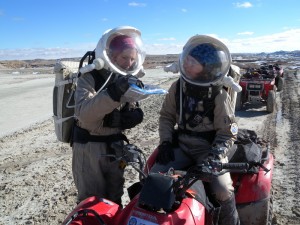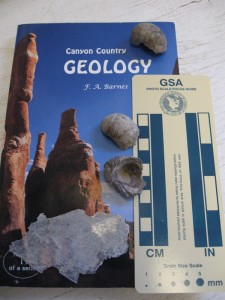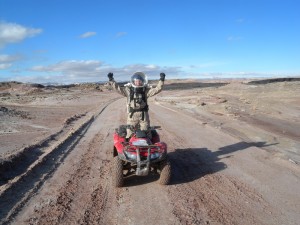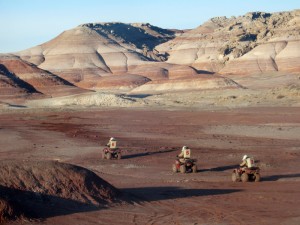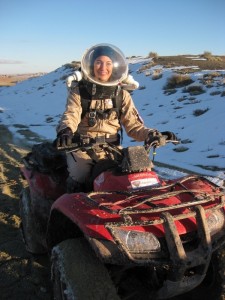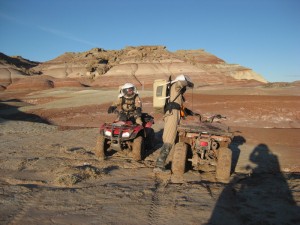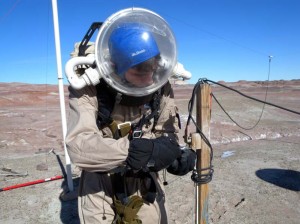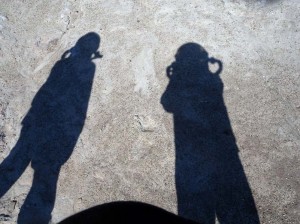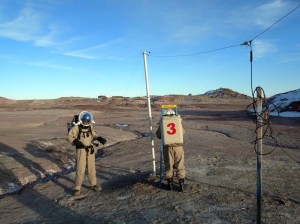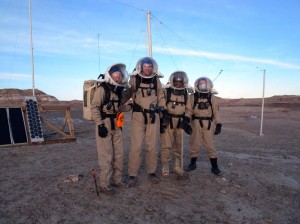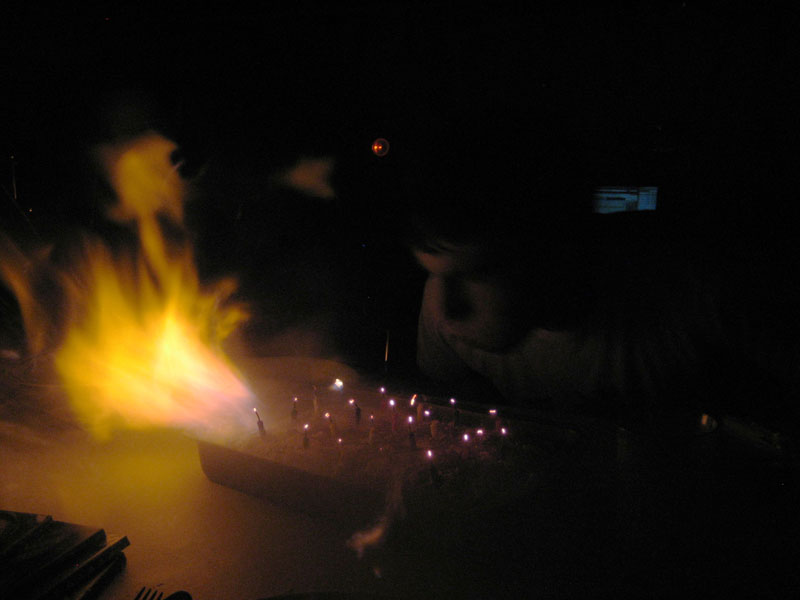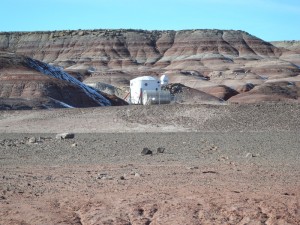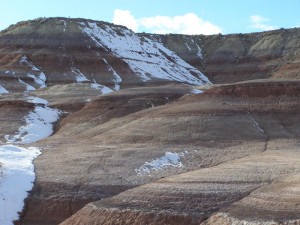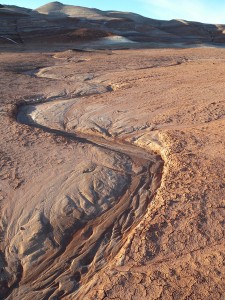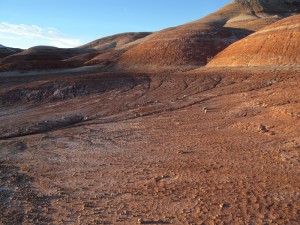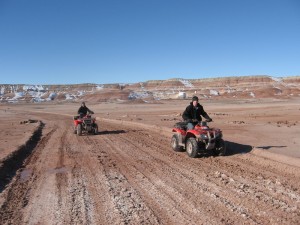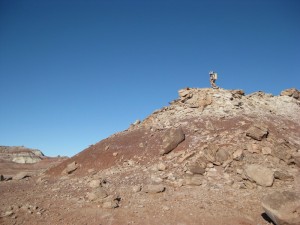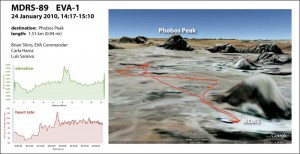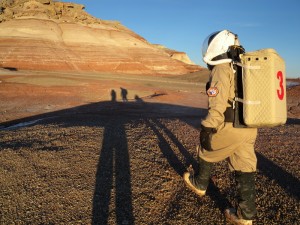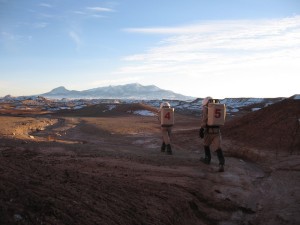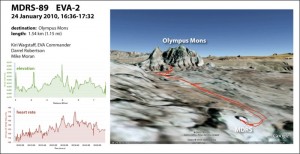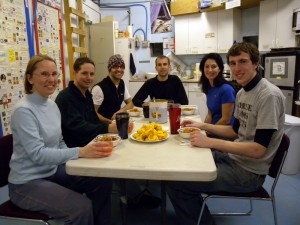Dinner was an interesting melange originally intended as a tofu stirfry, but ultimately more of a melange of tofu and reconstituted vegetables, plus a concoction intended to mimic a stirfry sauce (and approximately succeeding!).
January, 2010:
Sol 3: Over hill, over dale
Living on Mars
Possibly the biggest challenge to living within a cylindrical habitat with five other people is adjusting to the fact that outside is considered hostile. There are no leisurely walks, no strolls through the park, and no lying in grass watching clouds drift by. To speak of it, there’s no grass to speak of! Aside from EVAs, which are more work-oriented than anything else, and engineering rounds (same thing), there isn’t any opportunity to get out of the Hab for any extended period of time.
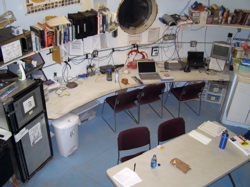 So, we’ve gotten used to these surroundings in the few days that we’ve been here, especially the upper deck of the Hab. This is where most of the work gets done: filing reports at the end of each day, planning EVAs, cooking, eating, relaxing, and bonding as a team. The space is very multi-purpose, with the main central table serving as both a kitchen table and a workstation (or game table), the kitchen sitting right next to the main workbench, and it allows access to every other part of the Hab.
So, we’ve gotten used to these surroundings in the few days that we’ve been here, especially the upper deck of the Hab. This is where most of the work gets done: filing reports at the end of each day, planning EVAs, cooking, eating, relaxing, and bonding as a team. The space is very multi-purpose, with the main central table serving as both a kitchen table and a workstation (or game table), the kitchen sitting right next to the main workbench, and it allows access to every other part of the Hab.
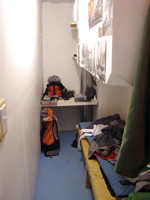
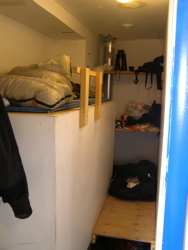 Our day, however, begins in the state rooms, each of which is composed of nothing more than a bunk and a small desk (and a few have installed shelving). For most of us, these state rooms are just for sleeping and storing anything we can’t leave out in the main room, although Brian and Carla do complete quite a bit of work in their larger rooms as benefit to being our Commander and XO, respectively. While my state room, pictured to the right, is quite messy, it’s more to allow access to anything I may need immediately, hence the spread of supplies on my desk.
Our day, however, begins in the state rooms, each of which is composed of nothing more than a bunk and a small desk (and a few have installed shelving). For most of us, these state rooms are just for sleeping and storing anything we can’t leave out in the main room, although Brian and Carla do complete quite a bit of work in their larger rooms as benefit to being our Commander and XO, respectively. While my state room, pictured to the right, is quite messy, it’s more to allow access to anything I may need immediately, hence the spread of supplies on my desk.
After waking up and getting dressed, breakfast and a morning meeting are held around the central table. Breakfast usually consists of oatmeal or cereal, along with whatever dried fruits or nuts we decide to include. Today I had Honey Nut Cheerios with powdered milk, plus some raisins on the side, for those of you that were wondering…
 Since we are in sim, the only time we can leave the Hab (aside from engineering rounds, which I’ll get too later) is while on EVA, or Extra-Vehicular Activity; those trips start in the EVA Prep Room, pictured to the right. Here is where we store everything that is needed for an EVA, at least everything that can be carried that isn’t specifically engineering related. During the suit-up procedure, the Marsonauts first put on their flight suits (hanging in the background). When we first arrived at MDRS, we tried on the suits until we found one that would fit, then Velcro-ed our mission patch and name tags onto our selected flight suits. They then don their boots and waders, along with their radios and headsets. At this point, their is usually also a com check between the Marsonauts and HabCom (the person who stays behind to communicate with those on the surface) before the suit-up procedure progresses.
Since we are in sim, the only time we can leave the Hab (aside from engineering rounds, which I’ll get too later) is while on EVA, or Extra-Vehicular Activity; those trips start in the EVA Prep Room, pictured to the right. Here is where we store everything that is needed for an EVA, at least everything that can be carried that isn’t specifically engineering related. During the suit-up procedure, the Marsonauts first put on their flight suits (hanging in the background). When we first arrived at MDRS, we tried on the suits until we found one that would fit, then Velcro-ed our mission patch and name tags onto our selected flight suits. They then don their boots and waders, along with their radios and headsets. At this point, their is usually also a com check between the Marsonauts and HabCom (the person who stays behind to communicate with those on the surface) before the suit-up procedure progresses. 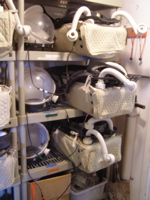 Once everything checks out, they then strap into their PLSS (Portable Life Support System), usually with the help of someone in the ready room. This backpack allows the EVA personnel to survive outside of the Hab as it filters and transfers breathable air to the helmet, which is put on next. A final check is made before the Marsonauts enter the airlock, where they must wait for five minutes for depressurization, before leaving the Hab and stepping out onto the surface. Once they return, this process is repeated in reverse, usually followed by a hot meal for the returning explorers.
Once everything checks out, they then strap into their PLSS (Portable Life Support System), usually with the help of someone in the ready room. This backpack allows the EVA personnel to survive outside of the Hab as it filters and transfers breathable air to the helmet, which is put on next. A final check is made before the Marsonauts enter the airlock, where they must wait for five minutes for depressurization, before leaving the Hab and stepping out onto the surface. Once they return, this process is repeated in reverse, usually followed by a hot meal for the returning explorers.
 During the day, a lot of the work is completed in the lower deck, which includes the EVA Prep Room, main airlock, Biology and Geology labs, engineering bay and airlock, as well as the bathroom and shower. Since our completed EVAs (four in total) haven’t been centered on either Biology and Geology, the main lab area (pictured) has mostly just been inventoried and cleaned by LuÃs, our Biologist. There is an EVA out currently that focuses on geology and geophysics, plus there is a planned EVA later today centered on biology, so this area will mostly likely being in use more for the rest of the mission. Darrel, our Engineer, is also using the area as an interior engineering bay and repair station for basically the entire Hab.
During the day, a lot of the work is completed in the lower deck, which includes the EVA Prep Room, main airlock, Biology and Geology labs, engineering bay and airlock, as well as the bathroom and shower. Since our completed EVAs (four in total) haven’t been centered on either Biology and Geology, the main lab area (pictured) has mostly just been inventoried and cleaned by LuÃs, our Biologist. There is an EVA out currently that focuses on geology and geophysics, plus there is a planned EVA later today centered on biology, so this area will mostly likely being in use more for the rest of the mission. Darrel, our Engineer, is also using the area as an interior engineering bay and repair station for basically the entire Hab.
 Speaking of engineering, the Hab also requires a power supply separate from the Hab and its vicinity. In a future Martian habitat, this power station will be much more than a diesel engine, so it needs to be separated from the Hab for the safety of the astronauts. During engineering rounds, Darrel and usually one other member of the crew (recently it has been either Kiri or Carla) check the power supply, batteries, ATVs, general Hab upkeep, Green Hab (which is both a greenhouse and a water recycling facility), and the various systems that are required in order to keep everything running smoothly. During a typical day, rounds are made in the morning (following the meeting) and at night before our mission support window opens at 2000 Local Time. This gives the engineer enough time to make the measurements and other checks, fix anything that needs fixing, and file a report so that (for any major problems), Mission Support can help troubleshoot things.
Speaking of engineering, the Hab also requires a power supply separate from the Hab and its vicinity. In a future Martian habitat, this power station will be much more than a diesel engine, so it needs to be separated from the Hab for the safety of the astronauts. During engineering rounds, Darrel and usually one other member of the crew (recently it has been either Kiri or Carla) check the power supply, batteries, ATVs, general Hab upkeep, Green Hab (which is both a greenhouse and a water recycling facility), and the various systems that are required in order to keep everything running smoothly. During a typical day, rounds are made in the morning (following the meeting) and at night before our mission support window opens at 2000 Local Time. This gives the engineer enough time to make the measurements and other checks, fix anything that needs fixing, and file a report so that (for any major problems), Mission Support can help troubleshoot things.
Once everyone is inside, the ATVs are shut down, the final rounds are made, and reports are filed, the rest of the day/night is for us. Usually that consists of preliminary planning sessions for the next day, eating the rest of the prepared dinner, and completing anything that couldn’t be completed during the day. Combusting cakes usually aren’t on the agenda, or if they were I wouldn’t know about them prior to, right?
All in all, just another day on Mars.
Sol 2: Patisserie Pyrotechnics
“HabCom,” Mike radioed, “We’re ready to enter the airlock.”
There was no response.
Mike tried again. The rest of us tried. We waved our arms at the tiny portholes on the second floor. But there was no response from Carla and Brian, who were (we hoped) still in the Hab. Now, we weren’t actually locked out. And we couldn’t actually run out of air. But this was only EVA #4, and in every previous case, there was immediate response from HabCom to any radio hail, and we always had someone in the EVA prep room to receive us. After five minutes or so, we decided to go in anyway. The sun was setting and the cold was setting in. Mike announced, “HabCom, we are entering the airlock,” and then we heard Brian’s most welcome voice: “EVA crew, copy that.” It turned out that the radio had been set with the volume too low for Carla and Brian to hear us, and they hadn’t expected us back so soon. We were soon in, de-suited, and de-briefed.On our return, Luis tackled the least appetizing task of the day: cleaning the toilet and shower enclosure. Yes, the shower! Although it has been inoperable for weeks, Darrel used his ingenuity to find the burst section of pipe and correct the problem. We’re looking forward to our very first showers this evening, which will go to Luis and Darrel! We’re all thrilled.
But the biggest thrill of the day came right after dinner. Our Crew Astronomer, Mike, turns 21 today. He had a very eventful day, including leading both our EVAs today as EVA Commander, getting the radio telescope closer to completion, and (as a surprise) a chocolate birthday cake made entirely from scratch! (Not trivial when you have no milk nor eggs!) Carla sprinkled it with powdered sugar, and we lit 21 candles on top while Mike was downstairs. When he came back up, we turned off the lights, sang “Happy Birthday”, and then Mike leaned over to blow them out. And a blowtorch erupted from the cake. I’ve never seen anything like it! Apparently his breath lofted most of the powdered sugar high enough to combust in the candle flame and what had been 21 shimmering lights turned into a cloud of flame. Phenomenal! And… don’t try this at home! But no worries: no one was singed. We laughed uproariously, turned the lights back on, wiped powdered sugar off the table, and Mike opened a card and chocolates (from Russia, via Carla!).
Happy Birthday, Mike! Thanks for spending your 21st with us!
The Painted Desert
I really cannot exaggerate the beauty of the surroundings we find ourselves in at the Mars Desert Research Station. I grew up in southeastern Utah, so I might have expected to be inured to it—but really, it is just phenomenal. During yesterday’s EVAs, we got to see a lot of the stunning sights, and local geology, first-hand.
The Hab sits in the Brushy Basin member of the Morrison Formation, from the Jurassic period. These rocks were formed from freshwater lake sediments, with occasional volcanic ash deposits. The colors in the resulting claystone, mudstone, and siltstone are just phenomenal—bands of rich red, cream, brown, yellow, and purple. Atop these bands lies pieces of the Dakota sandstone that you can just make out in the background hills in this picture (click to see larger version). Yes, that’s snow! We’ve been enjoying simply beautiful weather since we arrived: sunny, clear skies and temperatures in the upper 30’s to low 40’s during the day. The snow fell during the previous crew’s final days and remains on the north-facing slopes. More snow is forecast for tomorrow; I’m hoping it skips us, so that the rocks and formations remain in clear, brilliant view. Yesterday during EVA #2, we walked north from the Hab across very slippery red mud and clay. Daytime temperatures do get high enough to melt snow on the south-facing slopes, and it runs off the hills, both soaks into the soil and depositing the fine-grained mud layers we were walking on. We left giant bootprints in several areas, and skid marks where it was slipperier than it appeared. We also crossed some cracked mud areas where water had evaporated, and the “popcorn” surface created by smectite (a clay) when it dries out. At left is one of the meandering channels flowing from the foot of the hills out over the muddy plain. As the sun dropped in the sky, the shadows from every rock and pebble were highlighted, giving dramatic relief to the surface and emphasizing the angularity of the rocks. These rocks mostly come from the overlying Dakota sandstone, which is coarser-grained and more resistant to weathering than the soft mudstone and claystone of the Morrison Formation. The Dakota sandstone is the remnant of an inland ocean, so it arises from a very different water environment than the Morrison Formation does. We are told that this layer contains regions with coal, petrified wood, and bivalve fossils. We haven’t found these yet, but we hope to explore the Dakota more extensively in a future EVA! To the left is a picture of an outcrop of Dakota from EVA #1 (which explored the region around Phobos Peak). Its greater resistance to weathering is evident in how this large block rests on an undercut layer of Morrison supporting it. And finally, we used the rock hammer to collect a sample of a layered piece of Dakota that may possibly have some endoliths growing on it. We also reached a large chunk of Dakota sandstone at the base of Olympus Mons during EVA #2 (see right). Although at an entirely different location, it shows the same differential erosion. That’s Crew Astronomer Mike posing in front of the rock in his EVA suit, with our crew 89 patch on his arm. Thanks go to all of our crew for their great EVA work yesterday and the photos and stories they brought back! We’ll have another geology-oriented EVA coming up soon.Sol 1: Into the great outdoors
Brian put together a Google Earth map of the EVA, including elevation and heartrate data:
While Brian, Carla, and Luis were out on EVA #1, Darrel fixed a leak in the downstairs sink plumbing. He is extremely handy with every sort of tool and has been busy on multiple fronts, fixing anything that comes up.
Next, Darrel, Mike, and I suited up for EVA #2. This time getting into the suits went much quicker, although we still had to fiddle with the bungee cords. I stuck a rock hammer in my belt and borrowed Brian’s GPS-tagging camera to chronicle our expedition. We headed off north to Olympus Mons, trekking through soft, squishy red dirt and slipping in the muddy spots. No falls, though! We crossed a variety of alluvial areas, including drainage plains littered with angular rocks. It was an eerie sort of hike, entirely silent except for the rush of the air being pumped into the helmet, my own breathing, and the occasional squawk of the radios we carried. We paused partway to climb up onto an outcrop of stronger, pale yellow conglomerate, where Darrel used the rock hammer to split open a rock and collect a sample. The rich red mud rolled up and down, and we toiled along with it, hopping over several small channels. The colors, especially since we were near sunset, were just indescribable—beauty in all directions. At the foot of Olympus Mons, we took pictures next to a huge boulder. HabCom then notified us that we’d been out for 30 minutes and should head back home. It was starting to get really hard to see, as my helmet was fogging up, but I found that if I turned my head to the side and looked slantwise where I was going, I could see around the foggy area. Darrel suggested a “short cut” (no mushrooms, sadly) and we hiked up a steep hill on the snowy north face. The snowy regions turned out to be much easier to walk on, because not only did the crusty snow give our boots purchase, but the ground underneath was frozen rather than being soft slippery mud as on the south faces. We crested the hill and found we weren’t quite where we expected… so dropped back down to the plain and, a few minutes later, spied the white cylinder of our home away from home.And here’s a map of EVA 2:
On our return, Brian helped us get out of our suits, and then we were delighted to climb upstairs and be met with some absolutely delicious smells from the kitchen! But before eating, engineering rounds had to be done; so we pumped water from the external tank into our internal tank, checked the GreenHab, and refueled and covered the ATVs. How delighted we were to sit down to spicy arrabiata pasta with sausage, cheddar-garlic biscuits, and punch to drink. And really, I mean absolutely delicious! And a wonderful way to celebrate a fantastic, action-filled day at MDRS. I couldn’t ask for more awesome, fun, reliable, skilled, and just generally impressive crewmates!
